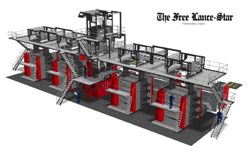Offset Printing
Q.I. PRESS CONTROLS MRC TO BE INSTALLED ON THE FIRST GOSS FPS PRESS IN US BY THE FREE LANCE-STAR

Friday 29. May 2009 - The Free Lance-Star in Fredericksburg, Virginia, is the first newspaper printer in the United States to invest in the Goss Flexible Printing System (FPS) press. Q.I. Press Controls North America is therefore very proud to announce being awarded the order for the delivery of the automatic register control for this new FPS press. 4 towers will be equipped with mRC cameras for closed loop color register control. In addition, 18 mRC cameras will be installed on the two folders and will automatically control the cut-off register.
“The FPS press at Free Lance-Star will have four towers and a 72-inch web-width for triple-width production. It will have the capacity to produce, in full color, 48-page broadsheet products running straight, 96-page broadsheet products running collect. In addition it has the ability to produce semi-commercial products with ribbon widths up to 36 inches and it will print with speeds up to 90.000 copies per hour. In order to fully automatically control both color and cut-off register on this extensive FPS press, we will install our mRC solution,” states Gerry Ferron, Managing Director of Q.I. Press Controls North America. “We are very proud to be able to say we are the first supplier of such control systems on a GOSS FPS press in the US market,” he continues. “It took quite some time and a joint effort, involving both Print2Finish, our agent for the US, Q.I. Press Controls North America along with our Headquarters in The Netherlands to bring this deal came about. But by visiting several reference sites, that gave the required assurance and confirmation of the innovative system offered by our intelligent solutions and by demonstrating the results achievable, we could convince them that mRC is the way of the future. Following Atlanta Journal Constitution and Transcontinental, The Free Lance-Star will be our third mRC site in the US. The installation of the press will start this summer and is expected to be operational early in 2010.”
